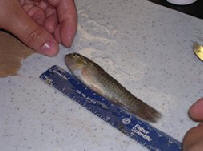|
Choked Up: How dead zones affect fish reproduction
Janet Raloff
Science News Online
13th November 2004
Several U.S. research teams report reproductive problems in Gulf Coast fish that periodically encounter oxygen at concentrations as low as those in so-called dead zones (SN: 6/5/04, p. 360: http://www.sciencenews.org/articles/20040605/bob9.asp). Two teams have also turned up gene changes that may underlie the diminished, less productive gonads found in these fish.
Size matters
Male killifish about to have his gonads weighed.
Photo: Cheek
Christie A. Landry of South-eastern Louisiana University in Hammond and her colleagues studied Gulf killifish, a type of minnow, in three bays where oxygen concentrations vary with the tide. In some cases, oxygen fluctuated only within healthy concentrations of 6 to 8 parts per million (ppm). Elsewhere, concentrations bottomed out for 3 hours a day at oxygen-starved, or hypoxic, values of 1 to 2 ppm. Last month in New Orleans at the E.Hormone conference on hormone-mimicking conditions in the environment, the researchers linked that hypoxia to reproductive changes.
Although the fish were similar in size in the three bays, testes in fish exposed to daily, transient hypoxia were only 34 to 50 percent as large, relative to body size, as those in males living where oxygen is always adequate, notes team leader Ann O. Cheek of the University of Texas Health Science Center at Houston. Ovaries in females exposed to daily hypoxia were only half as big and contained only one-seventh as many eggs as those in females getting sufficient oxygen all day. Fish at hypoxic sites also spawned on only half as many days as the other fish did.
In the wild, hypoxia didn't affect concentrations of sex hormones. In month long lab studies with killifish, by contrast, constant hypoxia roughly halved hormone concentrations, Cheek says.
Another team looked at spawning of Atlantic croakers. "We saw very dramatic effects of hypoxia in Pensacola Bay [Florida.], last year—effects more profound than I've ever seen with environmental contamination," reports Peter Thomas of the University of Texas at Austin Marine Science Institute in Port Aransas. His team studied year-old fish in an estuary suffering summer long hypoxia. None spawned at the expected time, or later, because the fish lacked mature eggs or sperm.
In the lab, Thomas observed similar problems when he subjected young croakers to hypoxia. In many instances, sperm or eggs were impaired. Compared with those of fish getting sufficient oxygen, sex-hormone concentrations in lab-reared hypoxic fish were extremely low. The affected fish also showed a dramatic elevation of activity in two genes triggered by a protein known as hypoxia-inducible factor (HIF).
Thomas will report his findings next week at the Society of Environmental Toxicology and Chemistry meeting in Portland, Ore.
At the E.Hormone meeting, a group from three New Orleans universities reported similar HIF changes in test-tube studies of gonadal and liver cells from trout. Under hypoxia—but not under normal oxygen conditions—HIF appears to pair up with another protein, called ARNT. The duo then binds to DNA in cells, turning on various genes, explains study leader Karla Johanning of Tulane University.
Although ARNT usually works with oestrogen to turn on other genes, hypoxic trout cells didn't react to oestrogen added to the test tubes. It would appear, Johanning says, that HIF tied up ARNT, limiting its collaboration with oestrogen. This may be a mechanism by which hypoxia alters fish reproduction, her team will propose at the upcoming meeting.
Top
|
